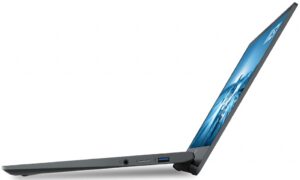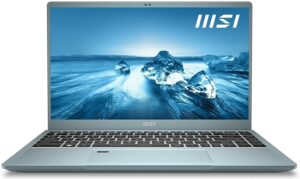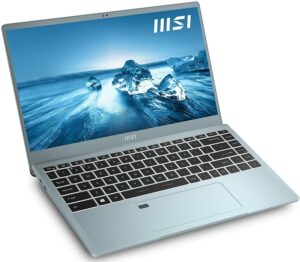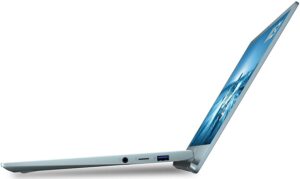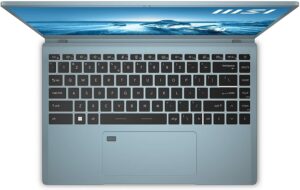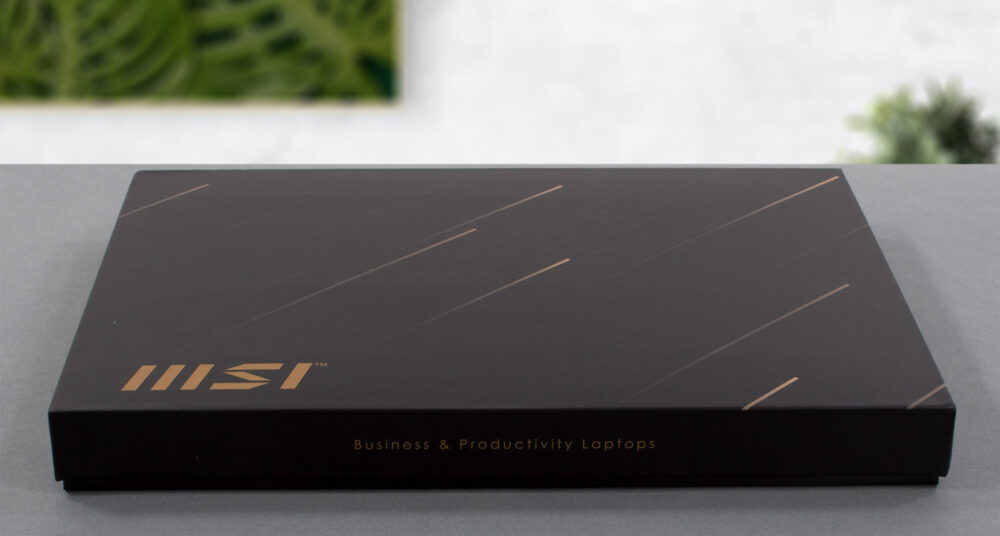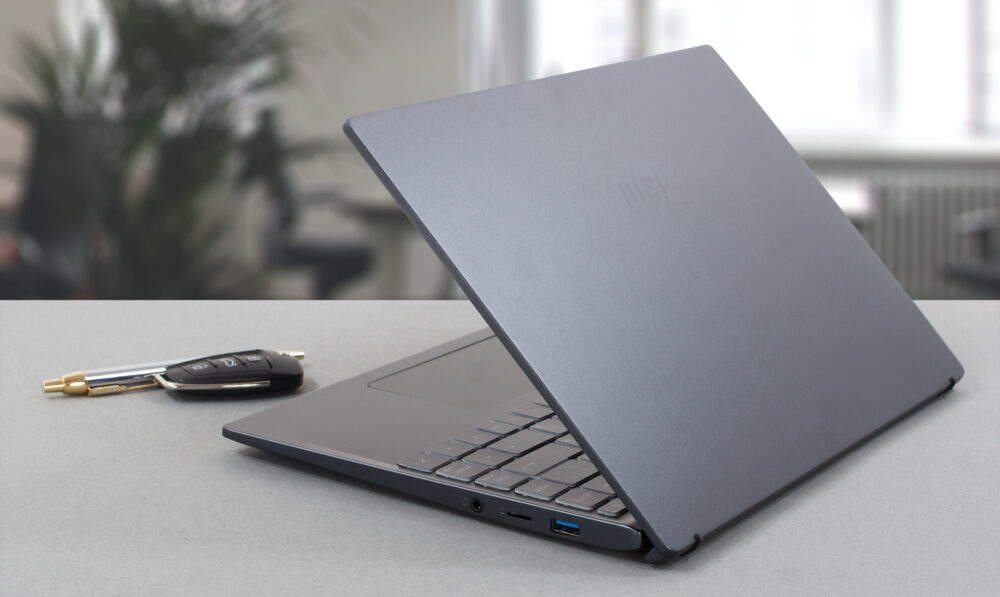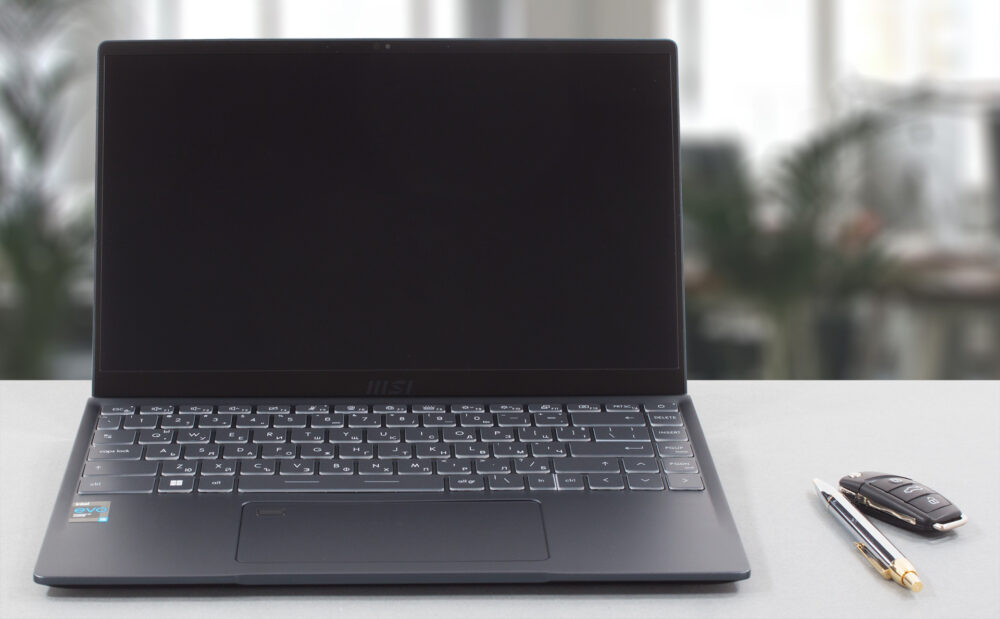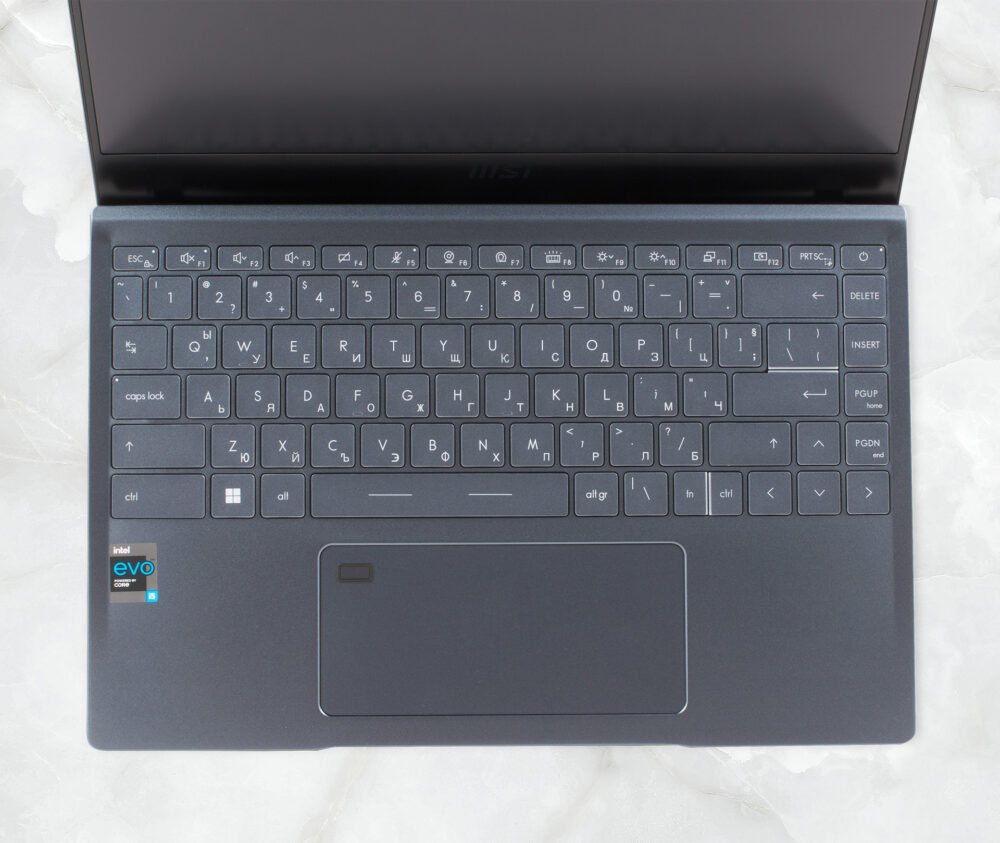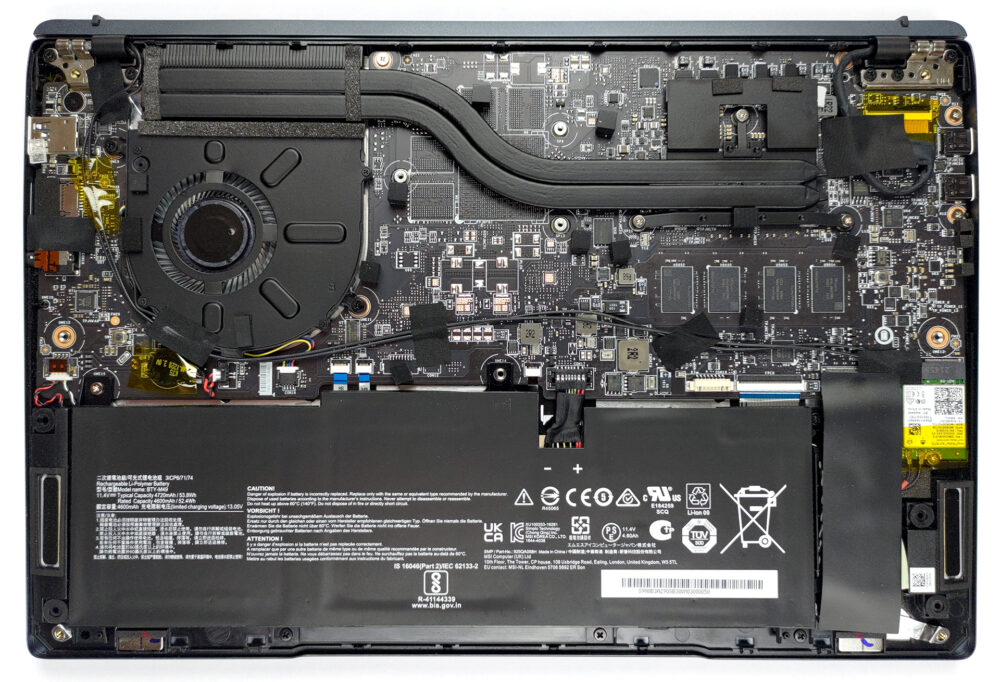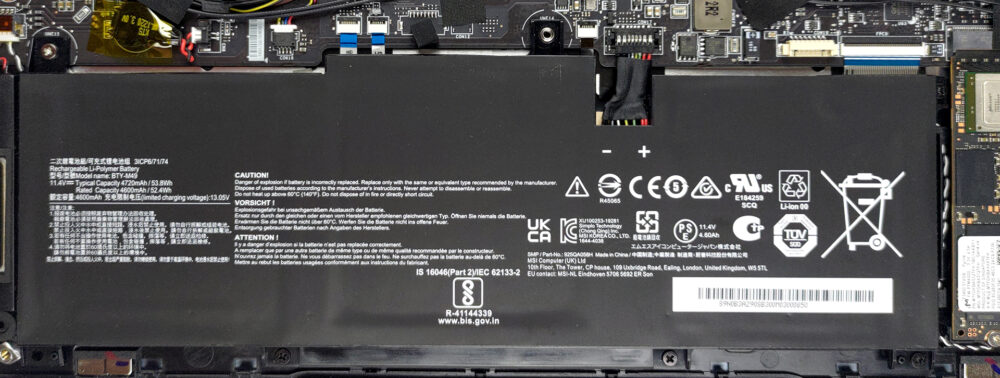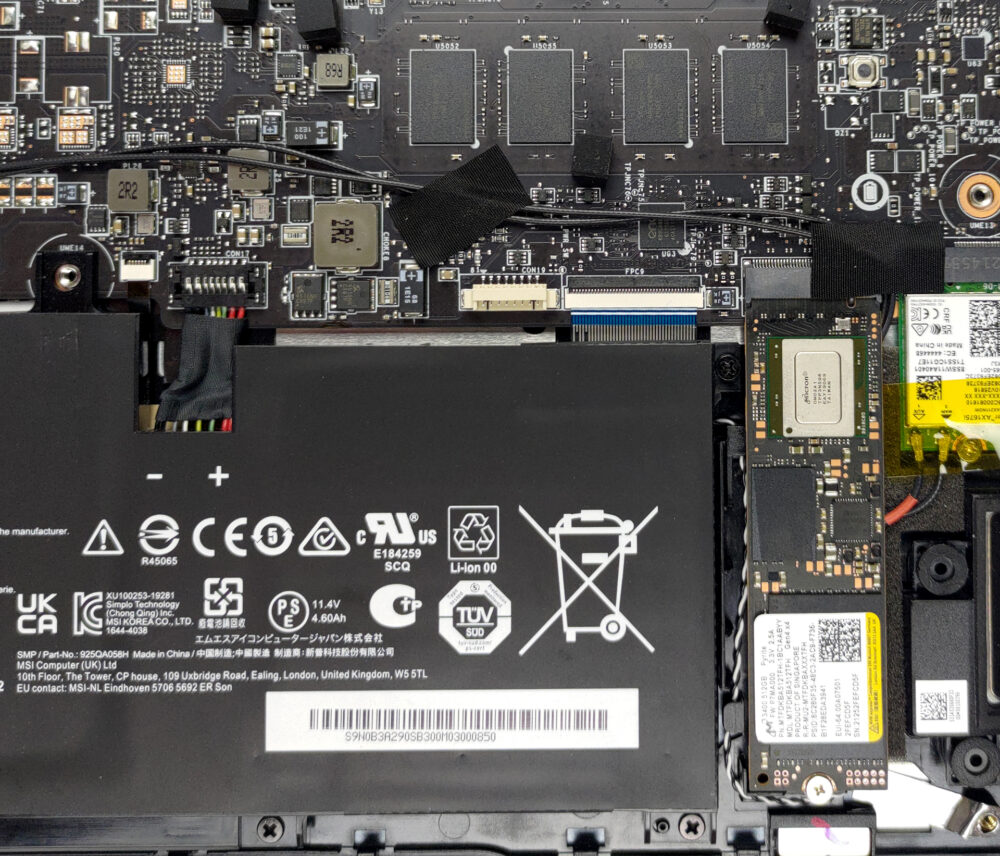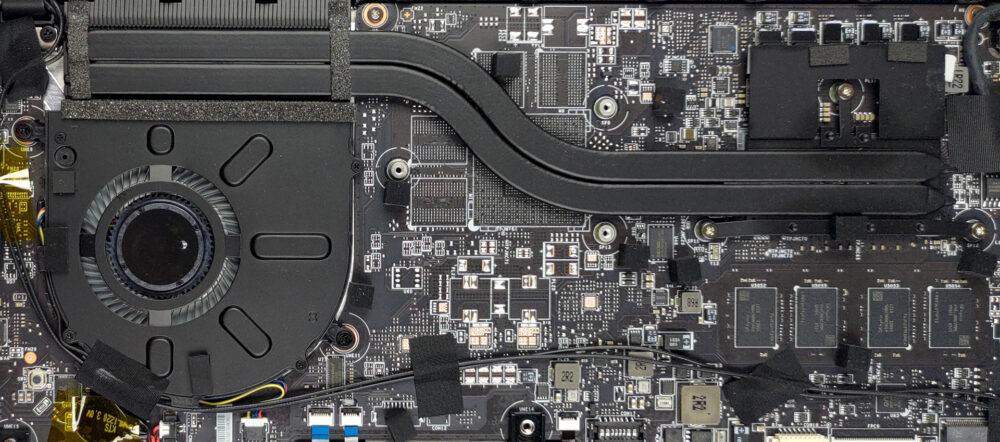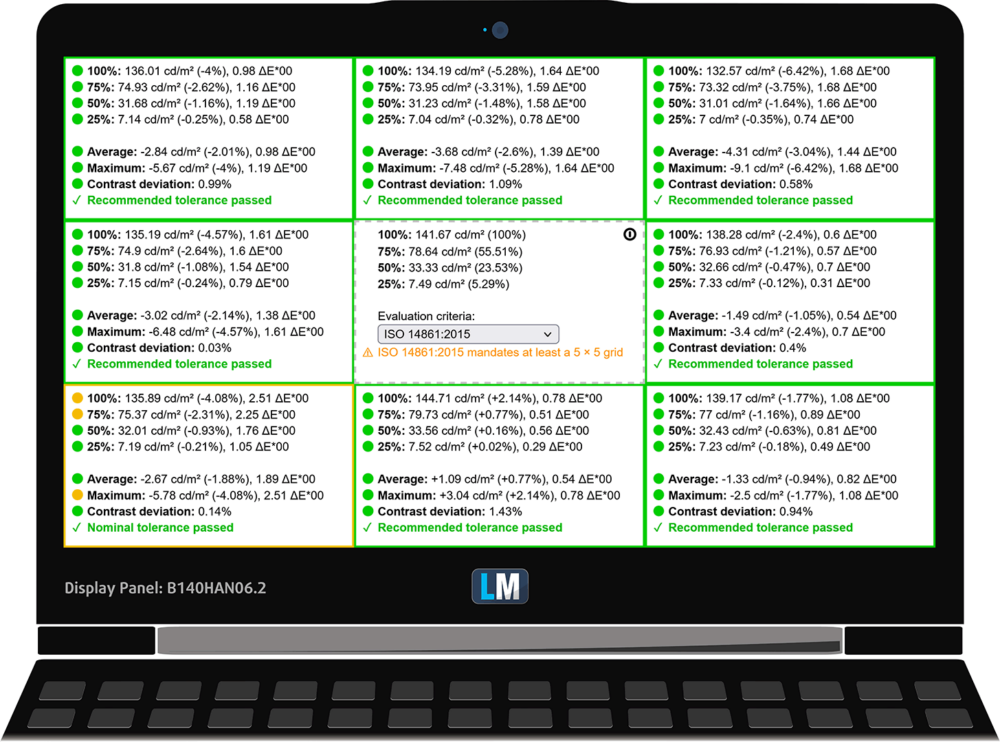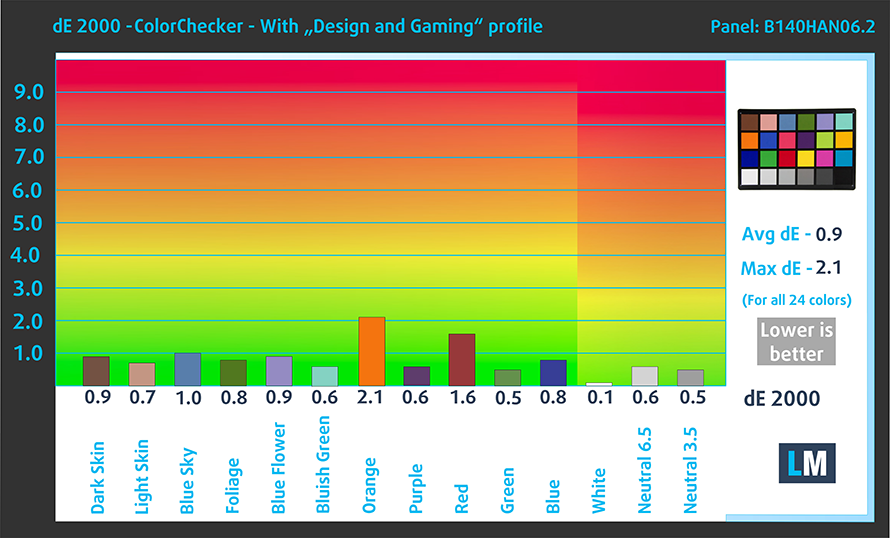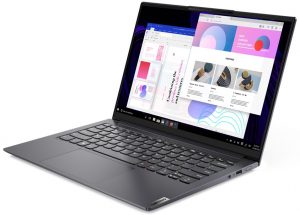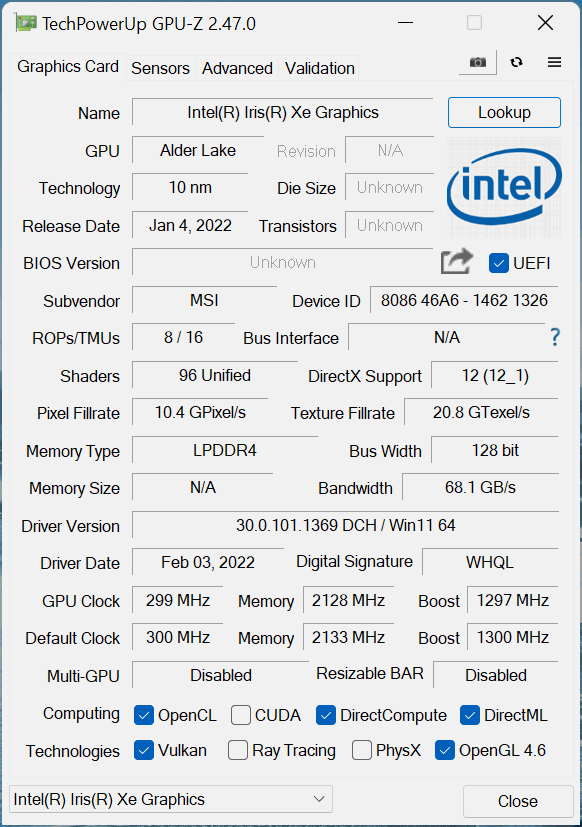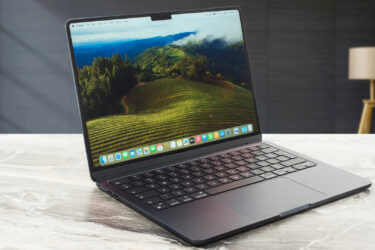MSI Prestige 14 (A12M) review
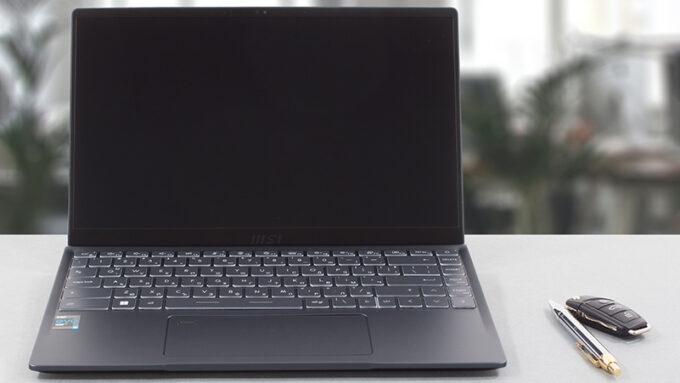 Sometimes you find yourself struggling to cope with your work. And many times, the reason for that is not the work itself, but what sits inside your brain. Burning out is a big issue in the modern world, as more and more people feel the stress of overperforming. To do so, one would want to take his/her time and enjoy life. In this case, the Prestige 14 (A12M) might come in handy, as it can be both your workhorse and entertainment machine.
Sometimes you find yourself struggling to cope with your work. And many times, the reason for that is not the work itself, but what sits inside your brain. Burning out is a big issue in the modern world, as more and more people feel the stress of overperforming. To do so, one would want to take his/her time and enjoy life. In this case, the Prestige 14 (A12M) might come in handy, as it can be both your workhorse and entertainment machine.
See, much like the smartphone, laptops have become a portal to not only the virtual world but a hub to the real world as well. After all, you use your mobile device to look for a place to go on the weekend, book your next trip, or buy a new set of shoes.
This theory is further affirmed if you are a photographer or videographer. Basically, you capture footage, which can then be enhanced by your laptop (something, which is certainly in Prestige 14 (A12M)’s a specialty), and then use it to inspire another human being in one way or another.
This is why you should pick a solid device, that won’t let you down. Actually, stability is one of the key ideas that sit behind Intel’s Evo platform. And Prestige 14 is part of it. What is even better is that it comes with Alder Lake-P series chips, which are the most powerful 28W chips currently occupying the mobile world. Now that we’ve learned what the laptop stands for, let’s see what it’s made of, and if it can deliver on MSI’s promises.
You can check the prices and configurations in our Specs System: https://laptopmedia.com/series/msi-prestige-14-a12mx-a12sx-a12ux/
Contents
Specs Sheet
- HDD/SSD
- up to 8000GB SSD
- M.2 Slot
- 1x 2280 PCIe NVMe 4.0 x4 See photo
- RAM
- up to 32GB
- OS
- Windows 11 Pro, Windows 10 Pro, Windows 11 Home, Windows 10 Home, No OS
- Battery
- 52Wh, 3-cell, 52.5Wh, 3-cell
- Body material
- Aluminum
- Dimensions
- 319 x 219 x 15.9 mm (12.56" x 8.62" x 0.63")
- Weight
- 1.29 kg (2.8 lbs)
- Ports and connectivity
- 1x USB Type-A
- 3.2 Gen 1 (5 Gbps)
- 2x USB Type-C
- 4.0, Thunderbolt 4, Power Delivery (PD), DisplayPort
- Card reader
- MicroSD
- Wi-Fi
- 802.11ax
- Bluetooth
- 5.2
- Audio jack
- 3.5mm Combo Jack
- Features
- Fingerprint reader
- optional
- Web camera
- HD
- Backlit keyboard
- Microphone
- Speakers
- 2x 2W, Stereo Speakers
- Optical drive
All MSI Prestige 14 (A12Mx / A12Sx / A12Ux) configurations
What’s in the box?
Inside this notebook’s packaging, we found some paperwork and a 65W USB Type-C charger.
Design and construction
This notebook’s housing is entirely made out of aluminum. Nevertheless, the material is so thin, that the laptop basically lacks the expected structural support. This makes it prone to flex.
On the other hand, it is really portable with a profile of 15.9mm and a weight of 1.29 kg. Ultimately, it barely has a presence in your bag, which is simply amazing.
Opening the lid is an easy task for one hand. The top and side bezels are pretty thin, with the former one housing an HD Web camera with an IR face recognition sensor. What is more interesting about this area is that the lid lifts the base from the ground. This has happened to be a tradition in the laptop world, and we have to give some credit to ASUS for popularizing the feature.
Impressively, the MSI Prestige 14 (A12M) does it quite dramatically, as the gap between the backside of the bottom panel and the surface it sits on, is quite large, as you can see from the image below.
Anyways, let’s focus on the keyboard, which features large keycaps (including the Arrow keys, which are very refreshing), and a backlight. The key travel is on the longer side, while the feedback is pretty clicky. This makes it a very comfortable unit for long typing sessions.
Now, looking at the extremely wide touchpad, we have to say that it is super smooth, thanks to the glass surface. Furthermore, it is very accurate and responsive. Our only issue with it is that the area around the fingerprint reader is basically unusable. On the other hand, the unit is so wide that you will rarely find that intrusive.
Here, the speakers are located on the bottom of the laptop. In addition, the bottom panel houses the ventilation grill. After it draws its cool air, the single fan exhausts it through a vent on the back of the base, essentially blowing at the bottom of the 14-inch IPS display.
Ports
On the left side, you will encounter two Thunderbolt 4 connectors. Then, on the right, you get a USB Type-A 3.2 (Gen. 1) port, a MicroSD card reader, and an audio jack.
Disassembly, upgrade options and maintenance
To access this notebook’s internals, you need to undo 7 Phillips-head screws. Then, pry the bottom panel with a plastic tool and lift it away from the chassis.
Inside, we find a 53.8Wh battery pack. It lasts for nearly 10 hours of Web browsing, or 8 hours of video playback. To remove it, unplug the connector, and undo all 5 Phillips-head screws, which hold the battery in place.
Unfortunately, all of the memory is soldered to the motherboard. The maximum amount you can get before purchase is 32GB of LPDDR4x RAM, working in quad-channel mode. Storage-wise, there is one M.2 PCIe x4 slot, which works with Gen 4 drives.
In terms of cooling, the laptop sports two heat pipes, which connect to a heat sink, and a fan. Thankfully, the VRMs are also being cooled down.
Display quality
MSI Prestige 14 (A12M)’s display has a Full HD IPS panel, model number AUO B140HAN06.2 (AUO623D). Its diagonal is 14″ (35.56 cm), and the resolution – 1920 х 1080. Additionally, the screen ratio is 16:9, the pixel density – 157 ppi, their pitch – 0.161 x 0.161 mm. The screen can be considered Retina when viewed from at least 56 cm (from this distance, the average human eye can’t see the individual pixels).

It has comfortable viewing angles. We have provided images at 45 degrees to evaluate quality.

Also, a video with locked focus and exposure.
The maximum measured brightness is 327 nits (cd/m2) in the middle of the screen and 313 nits (cd/m2) average across the surface with a maximum deviation of 6%. The Correlated Color Temperature on a white screen and at maximum brightness is 6980K (average) – slightly colder than the 6500K optimum for sRGB.
In the illustration below you can see how the display performs from a uniformity perspective. The illustration below shows how matters are for operational brightness levels (approximately 140 nits) – in this particular case at 44% Brightness (White level = 142 cd/m2, Black level = 0.08 cd/m2).
Values of dE2000 over 4.0 should not occur, and this parameter is one of the first you should check if you intend to use the laptop for color-sensitive work (a maximum tolerance of 2.0 ). The contrast ratio is very good – 1740:1.
To make sure we are on the same page, we would like to give you a little introduction to the sRGB color gamut and the Adobe RGB. To start, there’s the CIE 1976 Uniform Chromaticity Diagram that represents the visible specter of colors by the human eye, giving you a better perception of the color gamut coverage and the color accuracy.
Inside the black triangle, you will see the standard color gamut (sRGB) that is being used by millions of people on HDTV and on the web. As for the Adobe RGB, this is used in professional cameras, monitors, etc for printing. Basically, colors inside the black triangle are used by everyone and this is the essential part of the color quality and color accuracy of a mainstream notebook.
Still, we’ve included other color spaces like the famous DCI-P3 standard used by movie studios, as well as the digital UHD Rec.2020 standard. Rec.2020, however, is still a thing of the future and it’s difficult for today’s displays to cover that well. We’ve also included the so-called Michael Pointer gamut, or Pointer’s gamut, which represents the colors that naturally occur around us every day.
The yellow dotted line shows MSI Prestige 14 (A12M)’s color gamut coverage.
Its display covers 98% of the sRGB/ITU-R BT.709 (web/HDTV standard) in CIE1976.
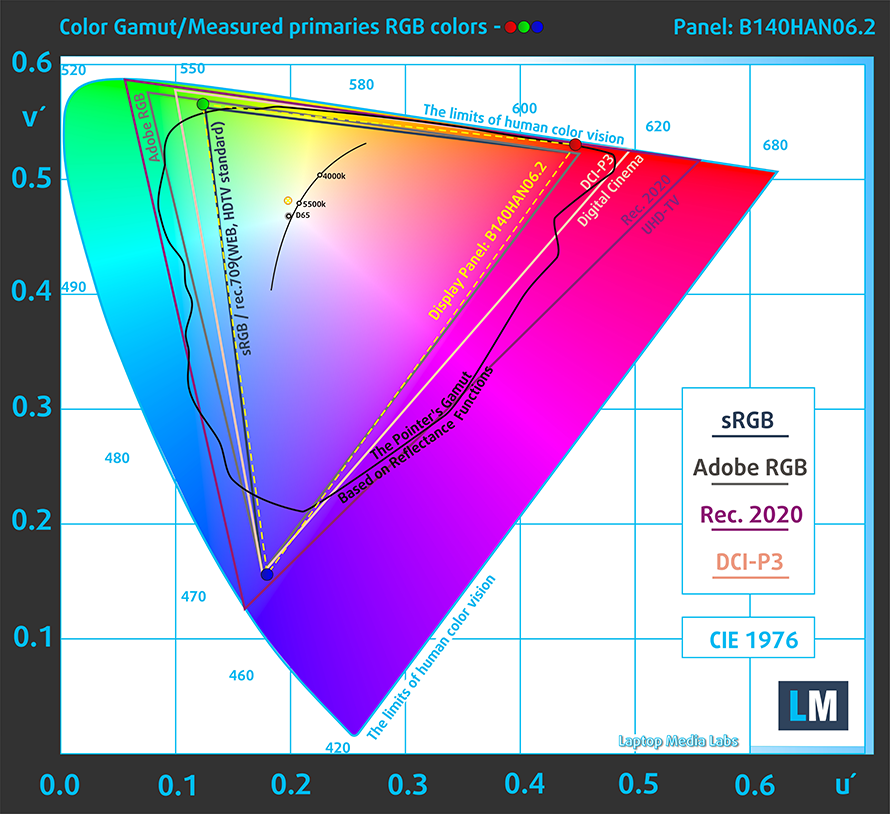
Our “Design and Gaming” profile delivers optimal color temperature (6500K) at 140 cd/m2 luminance and sRGB gamma mode.
We tested the accuracy of the display with 24 commonly used colors like light and dark human skin, blue sky, green grass, orange, etc. You can check out the results at factory condition and also, with the “Design and Gaming” profile.
Below you can compare the scores of MSI Prestige 14 (A12M) with the default settings (left), and with the “Gaming and Web design” profile (right).
The next figure shows how well the display is able to reproduce really dark parts of an image, which is essential when watching movies or playing games in low ambient light.
The left side of the image represents the display with stock settings, while the right one is with the “Gaming and Web Design” profile activated. On the horizontal axis, you will find the grayscale, and on the vertical axis – the luminance of the display. On the two graphs below you can easily check for yourself how your display handles the darkest nuances but keep in mind that this also depends on the settings of your current display, the calibration, the viewing angle, and the surrounding light conditions.

Response time (Gaming capabilities)
We test the reaction time of the pixels with the usual “black-to-white” and “white-to-black” method from 10% to 90% and vice versa.
We recorded Fall Time + Rise Time = 27 ms.
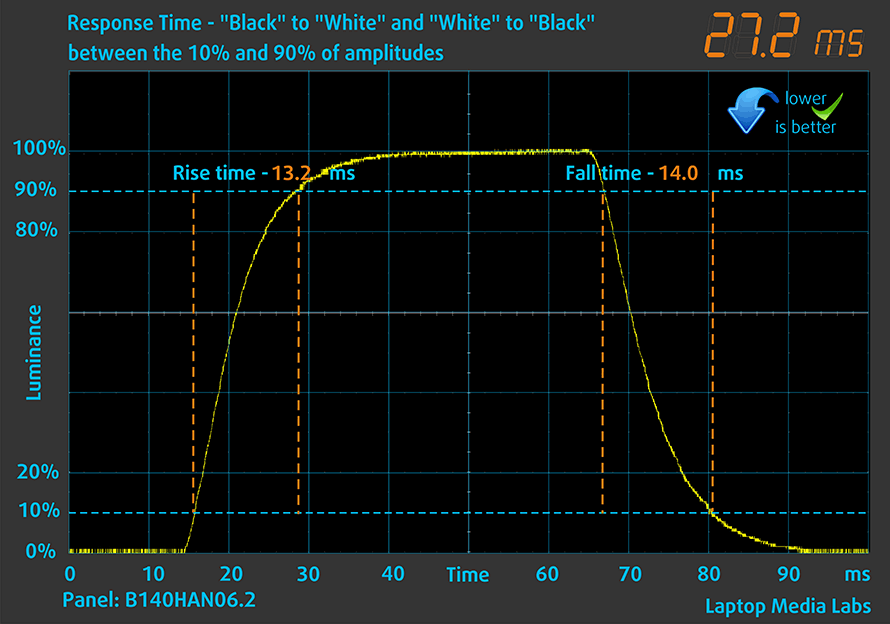
After that, we test the reaction time of the pixels with the usual “Gray-to-Gray” method from 50% White to 80% White and vice versa between 10% and 90% of the amplitude.
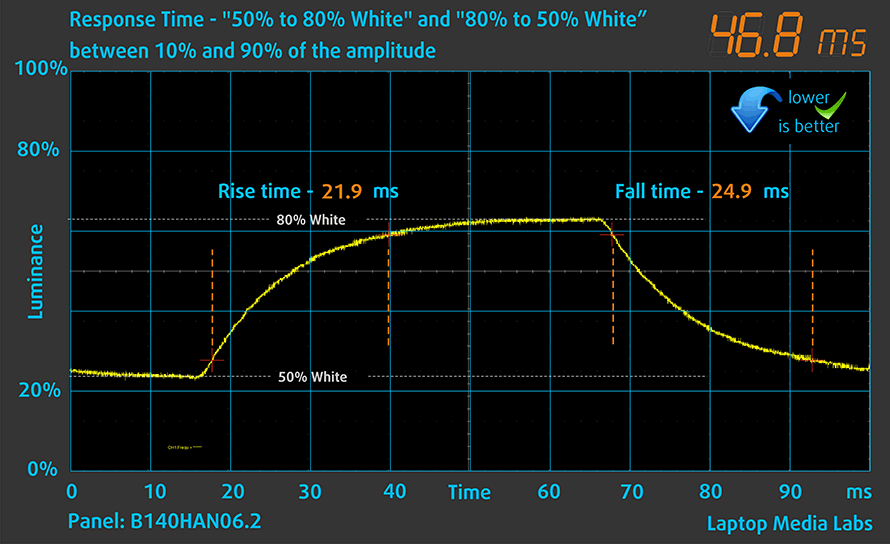
Health impact – PWM / Blue Light
PWM (Screen flickering)
Pulse-width modulation (PWM) is an easy way to control monitor brightness. When you lower the brightness, the light intensity of the backlight is not lowered, but instead turned off and on by the electronics with a frequency indistinguishable to the human eye. In these light impulses, the light/no-light time ratio varies, while brightness remains unchanged, which is harmful to your eyes. You can read more about that in our dedicated article on PWM.
MSI Prestige 14 (A12M)’s backlight doesn’t use PWM for brightness adjustment. This makes it comfortable for long periods of use.
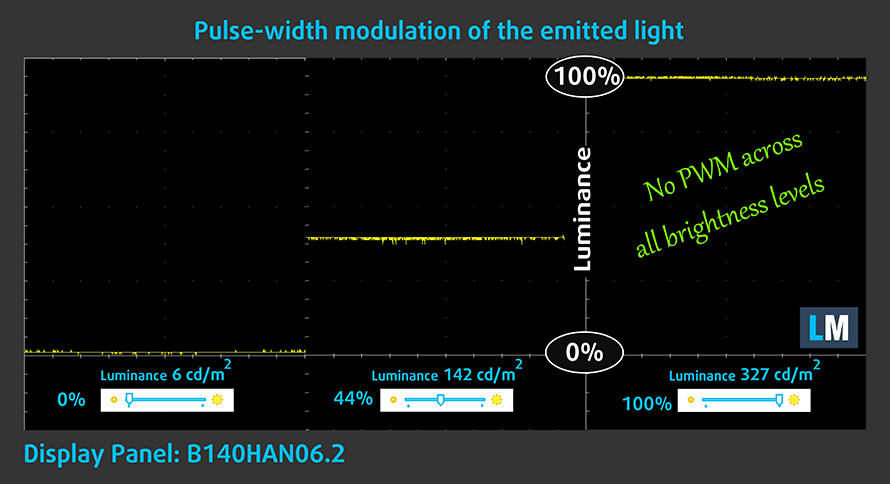
Blue light emissions
Installing our Health-Guard profile not only eliminates PWM but also reduces the harmful Blue Light emissions while keeping the colors of the screen perceptually accurate. If you’re not familiar with the Blue light, the TL;DR version is – emissions that negatively affect your eyes, skin, and your whole body. You can find more information about that in our dedicated article on Blue Light.
Gloss level measurement
Glossy-coated displays are sometimes inconvenient in high ambient light conditions. We show the level of reflection on the screen for the respective laptop when the display is turned off and the measurement angle is 60° (in this case, the result is 66.5 GU).
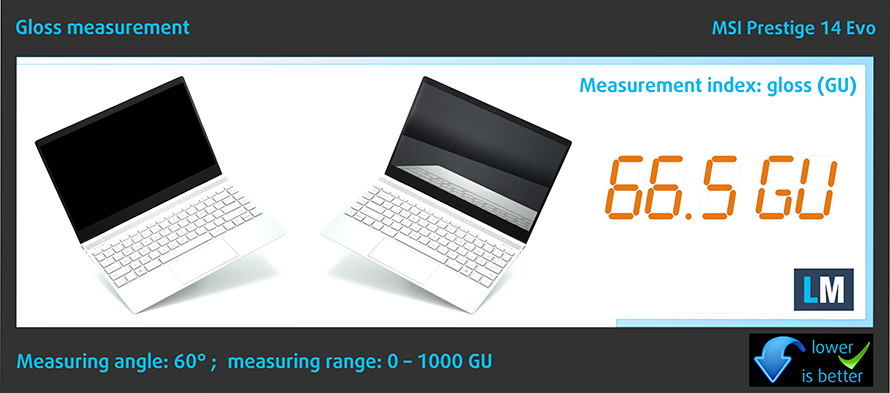
Buy our profiles
Since our profiles are tailored for each individual display model, this article and its respective profile package are meant for MSI Prestige 14 (A12M) configurations with 14.0″ AUO B140HAN06.2 (AUO623D) (FHD, 1920 × 1080) IPS.
*Should you have problems with downloading the purchased file, try using a different browser to open the link you’ll receive via e-mail. If the download target is a .php file instead of an archive, change the file extension to .zip or contact us at [email protected].
Read more about the profiles HERE.
In addition to receiving efficient and health-friendly profiles, by buying LaptopMedia's products you also support the development of our labs, where we test devices in order to produce the most objective reviews possible.

Office Work
Office Work should be used mostly by users who spend most of the time looking at pieces of text, tables or just surfing. This profile aims to deliver better distinctness and clarity by keeping a flat gamma curve (2.20), native color temperature and perceptually accurate colors.

Design and Gaming
This profile is aimed at designers who work with colors professionally, and for games and movies as well. Design and Gaming takes display panels to their limits, making them as accurate as possible in the sRGB IEC61966-2-1 standard for Web and HDTV, at white point D65.

Health-Guard
Health-Guard eliminates the harmful Pulse-Width Modulation (PWM) and reduces the negative Blue Light which affects our eyes and body. Since it’s custom tailored for every panel, it manages to keep the colors perceptually accurate. Health-Guard simulates paper so the pressure on the eyes is greatly reduced.
Get all 3 profiles with 33% discount
Drivers
All drivers and utilities for this notebook can be found here: https://www.msi.com/Business-Productivity/Prestige-14-Evo-A12MX/support?sub_product=Prestige-14Evo-A12M#driver
Battery
Now, we conduct the battery tests with the Windows Better performance setting turned on, screen brightness adjusted to 120 nits, and all other programs turned off except for the one we are testing the notebook with.
In order to simulate real-life conditions, we used our own script for automatic web browsing through over 70 websites.
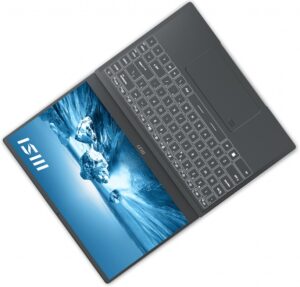
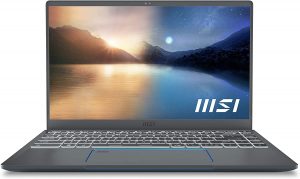
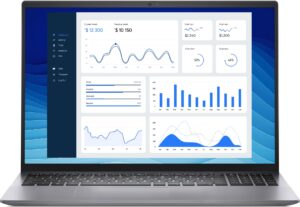
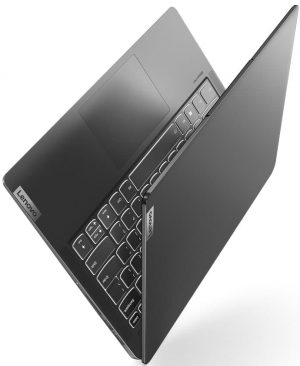

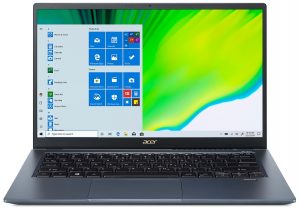
For every test like this, we use the same video in HD.






CPU options
This device can be found with the Core i5-1240P, Core i7-1260P, or Core i7-1280P, which proved to be an absolute beast when it’s cooled properly.
Results are from the Cinebench R23 CPU test (the higher the score, the better)
Results are from our Photoshop benchmark test (the lower the score, the better)
GPU options
Besides the integrated graphics, you can choose from the GTX 1650 Max-Q and the RTX 3050.
Results are from the 3DMark: Time Spy (Graphics) benchmark (higher the score, the better)
Results are from the 3DMark: Fire Strike (Graphics) benchmark (higher the score, the better)
Results are from the 3DMark: Wild Life benchmark (higher the score, the better)
Results are from the Unigine Superposition benchmark (higher the score, the better)
Gaming tests

| CS:GO | HD 1080p, Low (Check settings) | HD 1080p, Medium (Check settings) | HD 1080p, MAX (Check settings) |
|---|---|---|---|
| Average FPS | 149 fps | 100 fps | 68 fps |

| DOTA 2 | HD 1080p, Low (Check settings) | HD 1080p, Normal (Check settings) | HD 1080p, High (Check settings) |
|---|---|---|---|
| Average FPS | 158 fps | 111 fps | 62 fps |
Temperatures and comfort
Max CPU load
In this test we use 100% on the CPU cores, monitoring their frequencies and chip temperature. The first column shows a computer’s reaction to a short load (2-10 seconds), the second column simulates a serious task (between 15 and 30 seconds), and the third column is a good indicator of how good the laptop is for long loads such as video rendering.
Average P-core frequency; Average E-core frequency; CPU temp.; Package Power
| Intel Core i5-1240P (28W TDP) | 0:02 – 0:10 sec | 0:15 – 0:30 sec | 10:00 – 15:00 min |
|---|---|---|---|
| MSI Prestige 14 (A12M) | 3.18 GHz @ 2.46 GHz @ 71°C @ 64W | 2.22 GHz @ 1.97 GHz @ 73°C @ 37W | 1.79 GHz @ 1.69 GHz @ 81°C @ 31W |
| Lenovo Yoga 7i (14″, 2022) | 3.30 GHz @ 2.56 GHz @ 76°C @ 64W | 2.95 GHz @ 2.38 GHz @ 90°C @ 53W | 2.13 GHz @ 1.82 GHz @ 68°C @ 31W |
Interestingly, the Prestige 14 (A12M) doesn’t really show a great cooling performance. The Yoga 7i (14″, 2022) is significantly better in the long run, as it posts higher clock speeds at lower temperatures.
Comfort during full load
Also, the device becomes pretty warm under long periods of full load, and the single fan can get very loud.
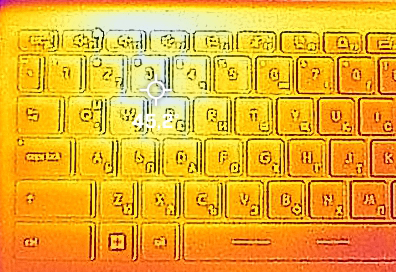
Verdict
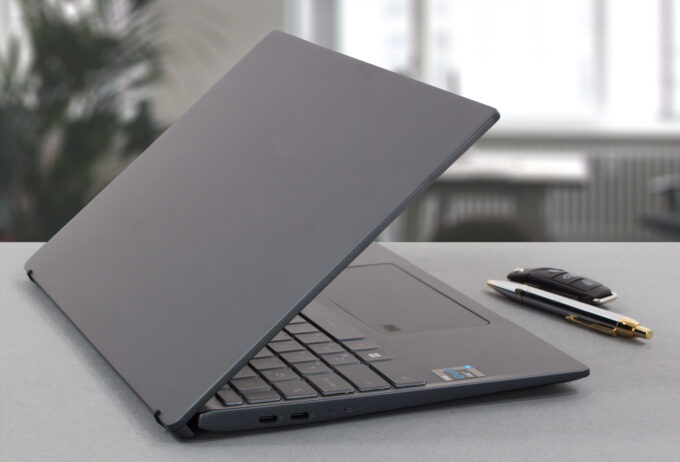 We have to say it straight on – the Prestige 14 (A12M) didn’t meet the expectations. The main reason for that is its lackluster cooling. Yes, it can sustain a higher power limit than the 28W base of the P-series Alder Lake chips. However, even a 2-in-1 competitor like the Lenovo Yoga 7i (14″, 2022) can keep a higher clock speed for a longer period of time, while running at a lower temperature.
We have to say it straight on – the Prestige 14 (A12M) didn’t meet the expectations. The main reason for that is its lackluster cooling. Yes, it can sustain a higher power limit than the 28W base of the P-series Alder Lake chips. However, even a 2-in-1 competitor like the Lenovo Yoga 7i (14″, 2022) can keep a higher clock speed for a longer period of time, while running at a lower temperature.
However, there is a key player in the performance of the Prestige – Intel’s Evo platform. It ensures that your device will meet a set of standards, and you can rely on it. To be completely honest, we found that to be true, and most of the time, laptops bearing the Evo platform logo come with quad-channel memory, albeit it is soldered to the motherboard. Furthermore, the single M.2 PCIe x4 slot supports Gen 4 drives.
MSI Prestige 14 (A12M)’s IPS panel has a Full HD resolution, a very good contrast ratio, and comfortable viewing angles. It has a pretty high color coverage of 98% of sRGB, and its backlight doesn’t use PWM for brightness adjustment. What’s even more impressive is that our Gaming and Web design profile brings the Average dE value below 1.0, which represents a very high color accuracy.
In addition to that, the laptop features an IR face recognition system, as well as a fingerprint reader for even safer logins. The input devices are surprisingly comfortable to use. Well, the I/O is a bit limited, but it has two Thunderbolt 4 connectors, a USB Type-A 3.2 (Gen. 1) port, and a MicroSD card slot.
Although the machine is made out of metal, it is not very sturdy and shows some flex even when lightly twisted. Generally, this is not a big issue, unless you are planning to hit people with your laptop.
Battery life is on the limit of bringing you an entire workday on a single charge. We got 10 hours of Web browsing or 8 hours of video playback. Ultimately, if you procrastinate most of your tasks until the next day, you will be able to get to the end of the current one with some juice left in your device.
So, at the end of the day, the Prestige 14 (A12M) can be used by content creators and specifically photo editors. Its color-accurate display (thanks to our Gaming and Web design profile), and nimble processor will make your work a piece of cake. However, you have to keep in mind that cooling is not your best friend with this particular device.
You can check the prices and configurations in our Specs System: https://laptopmedia.com/series/msi-prestige-14-a12mx-a12sx-a12ux/
Pros
- Two Thunderbolt 4 connectors and a MicroSD card reader
- Very thin and light body
- Its Full HD IPS panel has comfortable viewing angles and a good contrast ratio (AUO B140HAN06.2 (AUO623D))
- Covers 98% of sRGB and our Gaming and Web design profile helps it reach an Average dE of <2.0 (AUO B140HAN06.2 (AUO623D))
- No PWM (AUO B140HAN06.2 (AUO623D))
- Very high CPU performance
Cons
- Very warm and loud during gameplay
- Soldered memory (although working at quad-channel mode)
- Its cooling can’t keep high clocks for long periods of time


